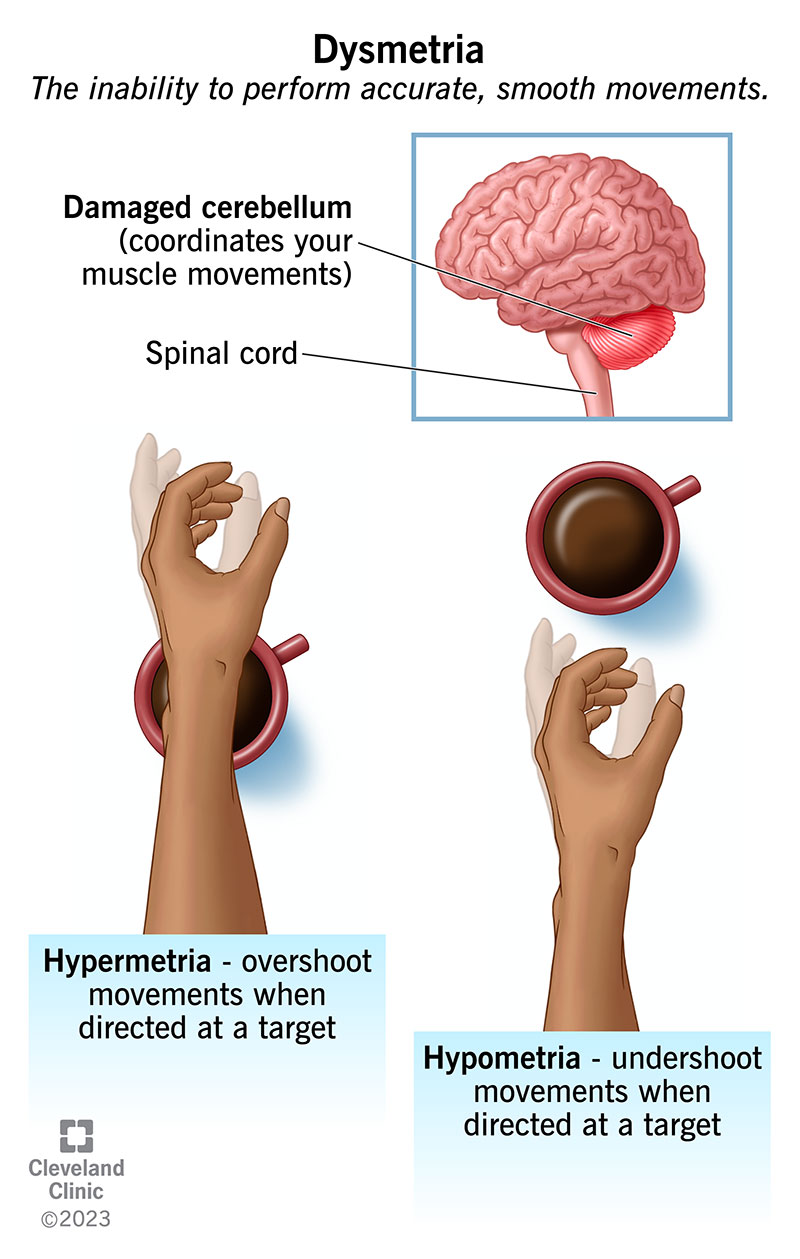Dysmetria is a symptom of cerebellar damage that interferes with your ability to perform accurate movements. Several conditions can cause dysmetria, including multiple sclerosis, stroke and traumatic brain injury. There aren’t any specific treatments for dysmetria, but physical and occupational therapy can help.

Dysmetria is the inability to perform accurate, smooth movements. You can either overshoot (hypermetria) or undershoot (hypometria) your movements when they’re directed at a target. In other words, if you have dysmetria, you can’t accurately judge the distance between yourself and the things you’re trying to reach or walk toward. Dysmetria is a form of ataxia (issues with coordination).
Dysmetria is a symptom — and/or a complication — of cerebellar damage. Your cerebellum is a part of your brain located at the back of your head, just above and behind where your spinal cord connects to your brain. One of the major functions of your cerebellum is to coordinate smooth muscle movements.
The coordination of muscle movements is a complex process. Every movement is the result of the combined activity of several muscles. In addition, your brain relies on sensory information to determine the space between you and things in your environment as you move. It also involves correct timing.
People with cerebellar damage often have other symptoms in addition to dysmetria, including:
Dysmetria is a specific type of ataxia.
Ataxia happens when you have a problem with coordination, causing you to move in an uncertain, awkward or even a wavering or clumsy way. It’s usually a sign of an issue with an area of your brain, ears or other parts of your nervous system.
Ataxia can refer to a group of diseases or as a symptom of certain diseases. As a symptom, ataxia is extremely common. Ataxia as a condition isn’t as common and tends to happen only with certain genetic conditions and diseases.
There are three main types of ataxia depending on which part of your body is damaged:
Dysmetria is a type of cerebellar ataxia.
Advertisement
Cleveland Clinic is a non-profit academic medical center. Advertising on our site helps support our mission. We do not endorse non-Cleveland Clinic products or services. Policy
Healthcare providers use the finger-to-nose test as part of a neurological exam to check for dysmetria and cerebellar damage.
In the finger-to-nose test, your provider asks you to reach for their finger with an outstretched arm and then touch your own nose with the same arm/hand. You repeat this process several times.
Another test is the heel-to-shin test. For this test, you place the heel of one foot on the shin of the other leg and then slide your heel down your shin in a straight line toward your foot.
A person without cerebellar ataxia (or dysmetria) will be able to perform these tests smoothly without issues. A person with dysmetria may have difficulty controlling their movements and may undershoot or overshoot their target. They may also experience tremors and make movement corrections as they perform the actions.
Damage to your cerebellum leads to dysmetria. Your cerebellum can experience damage in several ways, including:
Several neurodegenerative conditions can also cause cerebellum damage, including:
Advertisement
The treatment of dysmetria depends on the cause of cerebellar damage. In many cases, the brain damage that leads to dysmetria is permanent, so dysmetria is permanent, too.
There aren’t any specific treatments or medications to cure dysmetria, but the following therapies can help:
Many causes of dysmetria are unpreventable, like neurodegenerative disease and brain tumors.
But there are some ways to prevent specific causes of dysmetria and to keep your cerebellum healthy:
Advertisement
If you notice changes in how you move, such as issues with coordination and accuracy of movement, you should see a healthcare provider. They can perform a neurological exam and other tests to determine the underlying cause.
A note from Cleveland Clinic
Dysmetria is a symptom of conditions that affect your cerebellum. Your healthcare provider is the best person to tell you more about why you have this symptom and your options for treatment. They can also recommend treatments or ways to adapt to dysmetria to limit or prevent disruptions to your life.
Last reviewed on 09/06/2023.
Learn more about the Health Library and our editorial process.
Advertisement
Cleveland Clinic is a non-profit academic medical center. Advertising on our site helps support our mission. We do not endorse non-Cleveland Clinic products or services. Policy